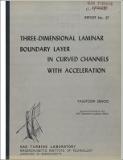Three-dimensional laminar boundary layer in curved channels with acceleration
Author(s)
Senoo, Y.
Download14200305.pdf (2.184Mb)
Other Contributors
Massachusetts Institute of Technology. Gas Turbine Laboratory
Metadata
Show full item recordAbstract
A theory is developed for two families of three-dimensional laminar boundary layers; namely, for the boundary layer on the parallel plane end walls of a curved channel with logarithmic spiral side walls, and for the boundary layer on the plane end wall of a concentric circular-arc channel having a particular family of accelerated or decelerated main flows. The second case shows the influence of acceleration and deceleration of a curved main flow. Numerical calculations show that acceleration makes the boundary layer thin and deceleration makes it thick, but the variation of thickness due to pressure gradient is very small compared with that in the two-dimensional case. The first case can be compared to the flow in a cascade. In this case, the variation of the width of the channel is directly related to the variation of the main flow velocity. According to the calculation, the boundary layer is thicker in an accelerated flow through a converging logarithmic spiral channel than in the decelerated flow through the same channel in the opposite direction. It is suspected that converging side walls make the end-wall boundary layer thick and that the effect of convergence is dominant over the effect of accelerated main flow. Experimental data on the end wall of a turbine nozzle cascade were compared with theoretical predictions, with fair agreement across the nozzle and along the center line of the nozzle.
Description
November 1956 Includes bibliographical references
Date issued
1956Publisher
Cambridge, Mass. : Gas Turbine Laboratory, Massachusetts Institute of Technology, [1956]
Series/Report no.
GTL report #37